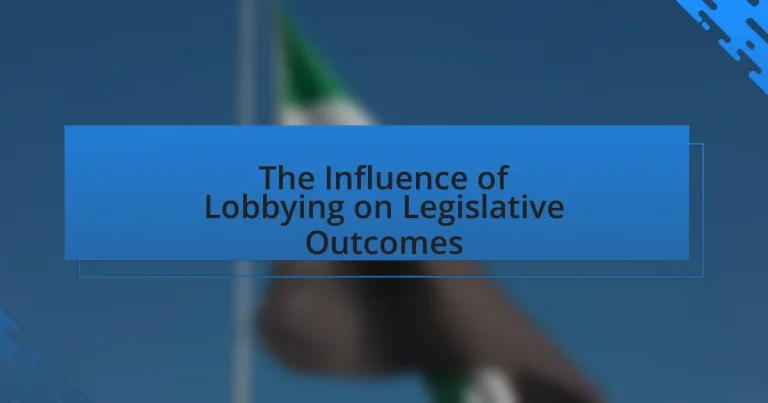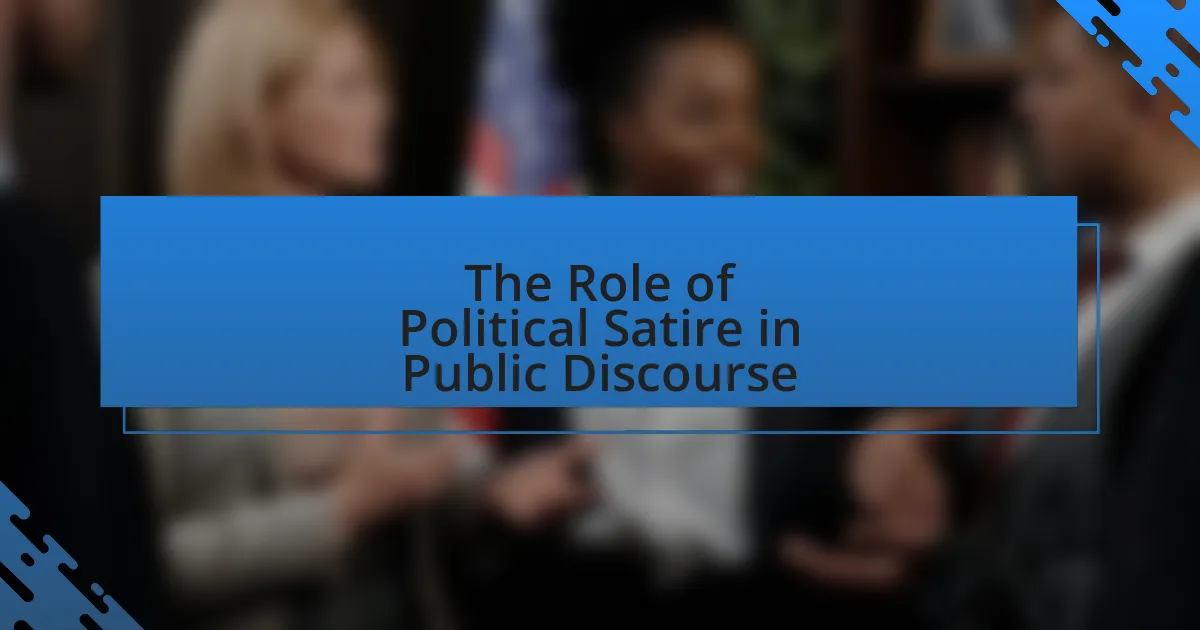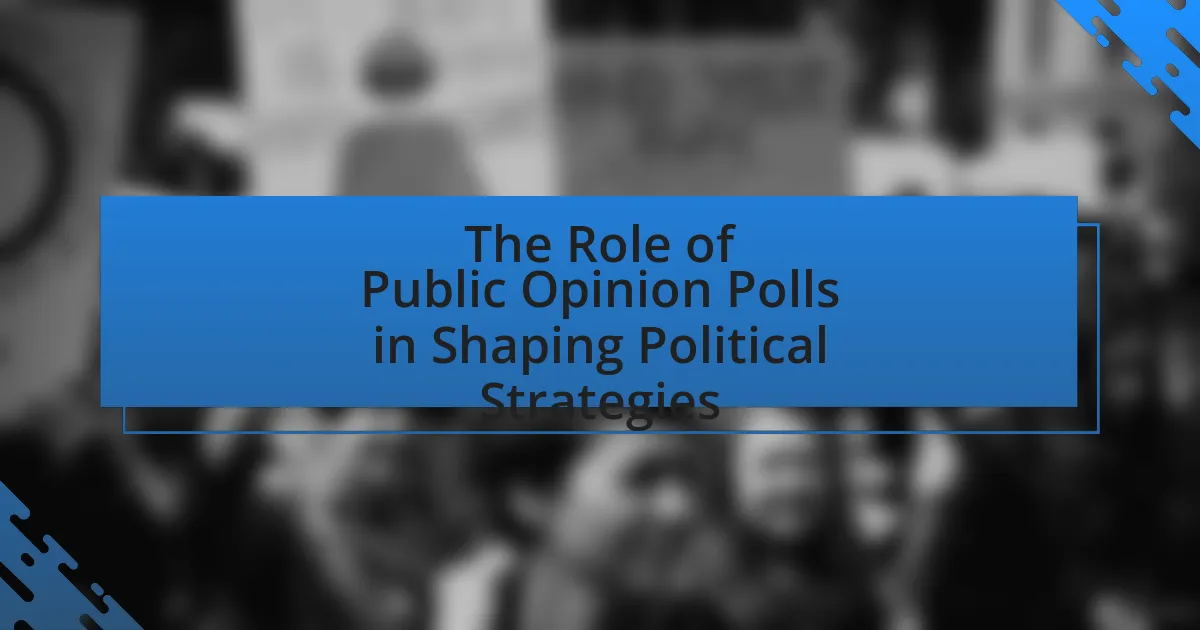The article examines the significant influence of lobbying on legislative outcomes, highlighting how lobbyists shape policy decisions and legislative agendas through direct communication, financial contributions, and grassroots mobilization. It discusses the substantial financial resources dedicated to lobbying, with over $3.5 billion spent in the United States in 2020, and explores the mechanisms through which lobbying affects the legislative process. Additionally, the article addresses the ethical considerations surrounding lobbying practices, the roles of various stakeholders, and the strategies employed by lobbyists to effectively sway lawmakers and public opinion. Historical examples and the impact of public perception on lobbying are also analyzed, providing a comprehensive overview of the complex dynamics at play in the legislative landscape.
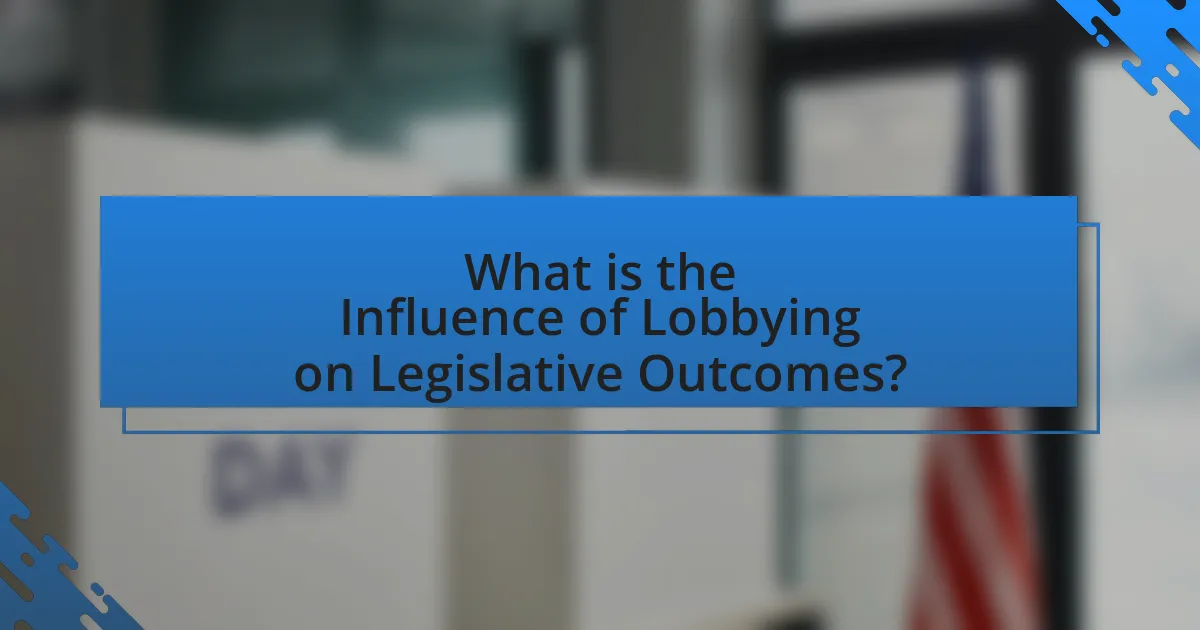
What is the Influence of Lobbying on Legislative Outcomes?
Lobbying significantly influences legislative outcomes by shaping policy decisions and legislative agendas. Lobbyists, representing various interest groups, provide information, resources, and advocacy to lawmakers, which can lead to the introduction, modification, or rejection of legislation. For instance, a study by the Center for Responsive Politics found that in 2020, over $3.5 billion was spent on lobbying in the United States, demonstrating the substantial financial resources dedicated to influencing legislative processes. This financial investment often correlates with the successful passage of legislation that aligns with the interests of those who lobby, highlighting the direct impact of lobbying on legislative outcomes.
How does lobbying impact the legislative process?
Lobbying significantly impacts the legislative process by influencing lawmakers’ decisions and shaping policy outcomes. Lobbyists, representing various interest groups, provide information, research, and advocacy to legislators, which can lead to the introduction of specific bills or amendments that align with their interests. For instance, according to the Center for Responsive Politics, in 2020, over $3.5 billion was spent on lobbying in the United States, demonstrating the substantial financial resources dedicated to influencing legislation. This financial influence can result in favorable regulations or funding for particular industries, thereby altering the legislative landscape to reflect the priorities of those who can afford to lobby effectively.
What are the key mechanisms through which lobbying influences legislation?
Lobbying influences legislation primarily through direct communication, financial contributions, and grassroots mobilization. Direct communication involves lobbyists meeting with lawmakers to advocate for specific policies, providing them with information and arguments that align with their interests. Financial contributions, often in the form of campaign donations, can enhance a lobbyist’s access to legislators and increase their influence over legislative priorities. Grassroots mobilization engages the public to advocate for or against legislation, creating pressure on lawmakers to respond to constituents’ concerns. These mechanisms are supported by research indicating that lobbyists who effectively combine these strategies can significantly sway legislative outcomes, as evidenced by the substantial impact of lobbying expenditures on policy decisions in various sectors.
How do lobbyists interact with lawmakers to shape outcomes?
Lobbyists interact with lawmakers primarily through direct communication, providing information, and advocating for specific policies or legislation. This interaction often occurs in the form of meetings, phone calls, and written correspondence where lobbyists present data, research, and arguments to persuade lawmakers to support their interests. For instance, the Center for Responsive Politics reported that in 2020, over $3.5 billion was spent on lobbying efforts in the United States, highlighting the significant resources dedicated to influencing legislative outcomes. Additionally, lobbyists may organize grassroots campaigns or mobilize constituents to contact their representatives, further amplifying their influence on lawmakers’ decisions.
Why is lobbying considered a significant factor in legislative decisions?
Lobbying is considered a significant factor in legislative decisions because it directly influences lawmakers’ priorities and the legislative agenda. Lobbyists provide specialized information, resources, and advocacy that can shape policy outcomes. For instance, according to the Center for Responsive Politics, in 2020, over $3.5 billion was spent on lobbying in the United States, demonstrating the financial resources dedicated to influencing legislation. This substantial investment underscores the role of lobbying in swaying legislative decisions and highlights its impact on the political process.
What historical examples illustrate the impact of lobbying on legislation?
Historical examples illustrating the impact of lobbying on legislation include the National Rifle Association’s (NRA) influence on gun control laws and the American Medical Association’s (AMA) role in shaping healthcare policy. The NRA has successfully lobbied against numerous gun control measures, notably defeating the 1993 Brady Bill, which aimed to implement background checks for gun purchases. This resistance has significantly shaped U.S. gun legislation. Similarly, the AMA has been instrumental in advocating for policies that benefit physicians and healthcare providers, such as the opposition to the public option in the Affordable Care Act, which was influenced by their lobbying efforts. These examples demonstrate how organized lobbying can effectively alter legislative outcomes in favor of specific interest groups.
How does public perception of lobbying affect legislative outcomes?
Public perception of lobbying significantly influences legislative outcomes by shaping lawmakers’ decisions and priorities. When the public views lobbying negatively, legislators may feel pressured to align with constituents’ sentiments, leading to more cautious or restrictive legislative actions regarding the interests being lobbied. For instance, a 2019 study published in the American Economic Journal found that increased public scrutiny of lobbying activities resulted in a decline in favorable legislation for industries perceived as overly influential, such as tobacco and fossil fuels. This demonstrates that public opinion can act as a check on lobbying power, ultimately affecting the legislative process and outcomes.
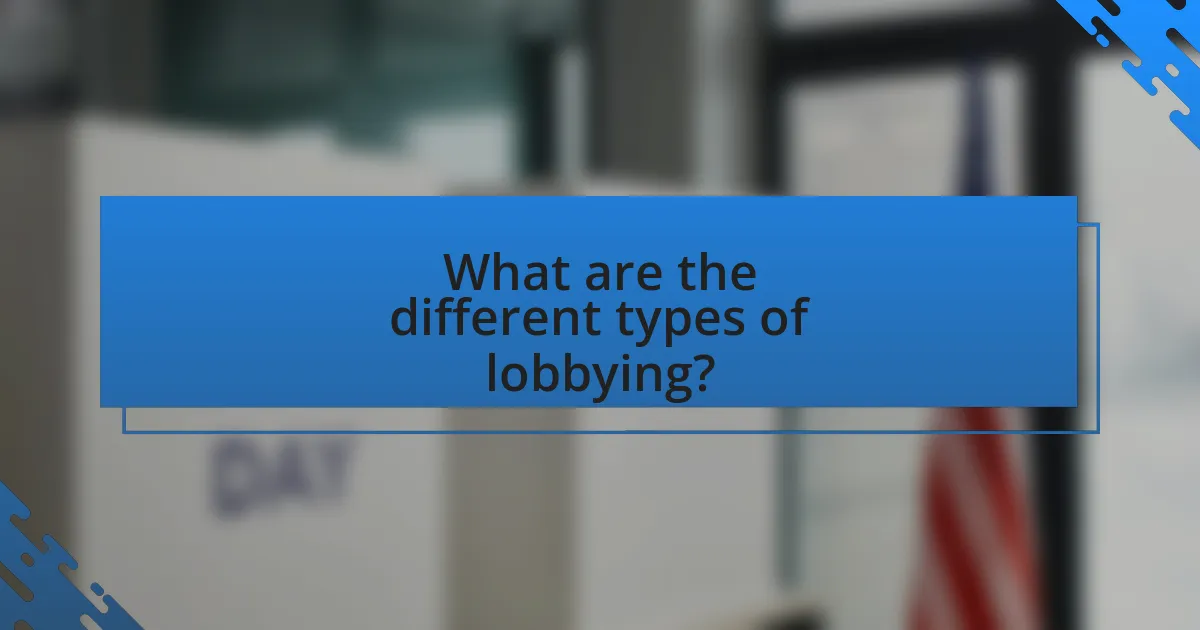
What are the different types of lobbying?
There are several types of lobbying, including direct lobbying, grassroots lobbying, and coalition lobbying. Direct lobbying involves direct interaction with lawmakers or their staff to influence legislation, often conducted by professional lobbyists representing specific interests. Grassroots lobbying mobilizes the general public to contact legislators and express their views, aiming to create a groundswell of support for a particular issue. Coalition lobbying occurs when multiple organizations or groups come together to advocate for a common goal, leveraging their collective resources and influence to enhance their impact on legislative outcomes. Each type plays a distinct role in shaping policy and influencing decision-makers.
What are the main categories of lobbying activities?
The main categories of lobbying activities are direct lobbying, grassroots lobbying, and coalition lobbying. Direct lobbying involves direct interaction with legislators or government officials to influence policy decisions. Grassroots lobbying focuses on mobilizing the public to contact their representatives, thereby creating pressure for specific legislative outcomes. Coalition lobbying occurs when multiple organizations or interest groups collaborate to advocate for a common cause, amplifying their influence through collective action. These categories are essential for understanding how different strategies are employed to shape legislative outcomes effectively.
How do direct and indirect lobbying differ in their approaches?
Direct lobbying involves direct interaction between lobbyists and lawmakers to influence legislation, while indirect lobbying seeks to influence public opinion or mobilize constituents to pressure lawmakers. Direct lobbying typically includes meetings, phone calls, and written communications with legislators, focusing on specific policy proposals. In contrast, indirect lobbying utilizes media campaigns, grassroots movements, and public relations strategies to shape perceptions and encourage constituents to advocate for or against legislation. This distinction is crucial as direct lobbying often results in immediate legislative changes, whereas indirect lobbying aims for broader, long-term shifts in public sentiment that can eventually influence lawmakers’ decisions.
What role do grassroots lobbying efforts play in influencing legislation?
Grassroots lobbying efforts play a crucial role in influencing legislation by mobilizing public support to pressure lawmakers. These efforts often involve community organizing, advocacy campaigns, and direct communication with legislators, which can significantly impact decision-making processes. For instance, a study by the American Political Science Review found that grassroots movements can lead to increased legislative responsiveness, particularly when constituents express strong opinions on specific issues. This demonstrates that when citizens engage in grassroots lobbying, they can effectively shape policy outcomes and legislative priorities.
What are the ethical considerations surrounding lobbying?
The ethical considerations surrounding lobbying include transparency, accountability, and the potential for undue influence on policymakers. Transparency is crucial as it ensures that lobbying activities are disclosed, allowing the public to understand who is attempting to influence legislation. Accountability involves holding lobbyists and lawmakers responsible for their actions, ensuring that decisions are made in the public interest rather than for personal or corporate gain. The potential for undue influence arises when lobbyists, often representing powerful interests, can sway legislative outcomes disproportionately, leading to policies that may not reflect the needs or desires of the broader population. For instance, studies have shown that industries with significant lobbying expenditures often achieve favorable legislation, raising concerns about equity and fairness in the political process.
How do regulations govern lobbying practices?
Regulations govern lobbying practices by establishing legal frameworks that dictate how lobbyists can operate, ensuring transparency and accountability. In the United States, the Lobbying Disclosure Act of 1995 requires lobbyists to register and report their activities, including the amount spent on lobbying efforts and the specific issues they are advocating for. This act aims to provide the public with insight into lobbying activities and to prevent corruption by mandating disclosures that allow for scrutiny of lobbyist interactions with government officials. Additionally, various states have their own lobbying regulations that may impose stricter requirements, further reinforcing the governance of lobbying practices at both federal and state levels.
What are the potential consequences of unethical lobbying practices?
Unethical lobbying practices can lead to significant consequences, including the erosion of public trust in government institutions. When lobbyists engage in deceptive tactics or fail to disclose their financial interests, it undermines the integrity of the legislative process. This can result in policies that favor special interests over the public good, as evidenced by instances where legislation has been influenced by undisclosed financial contributions, leading to regulatory capture. Furthermore, unethical lobbying can contribute to increased political polarization, as citizens become disillusioned with a system perceived as corrupt, ultimately diminishing civic engagement and participation in democratic processes.
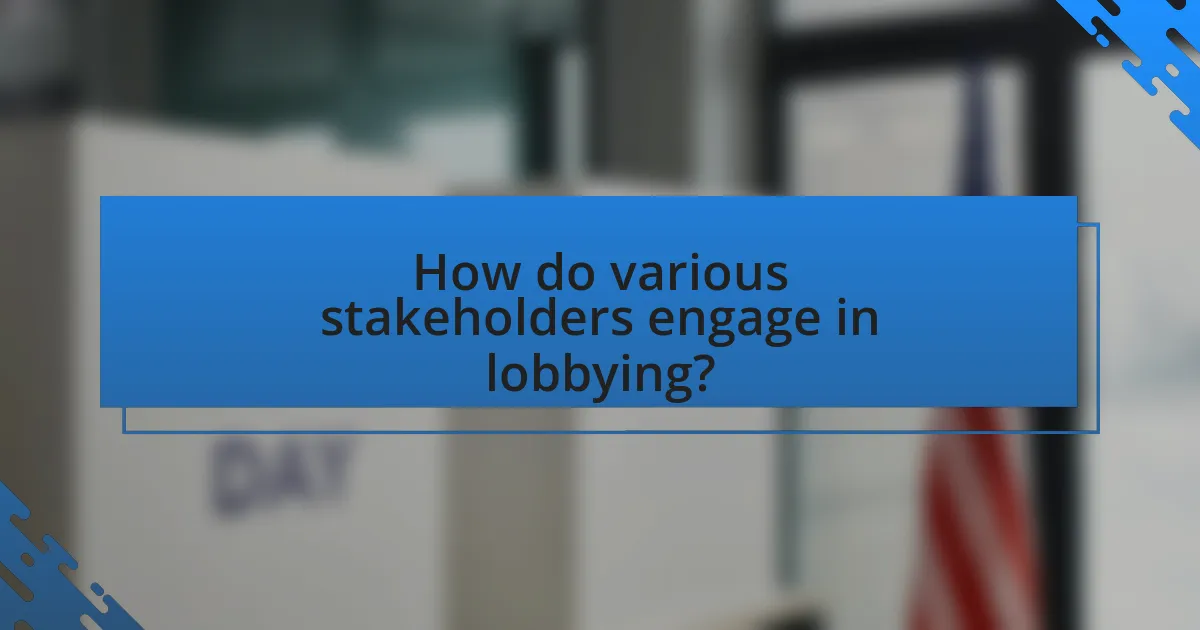
How do various stakeholders engage in lobbying?
Various stakeholders engage in lobbying by directly interacting with legislators and government officials to influence policy decisions. Corporations often employ lobbyists to advocate for favorable regulations, while non-profit organizations mobilize grassroots campaigns to raise public awareness and pressure lawmakers. Trade associations represent specific industries, providing data and expertise to support their positions. Additionally, individuals may engage in lobbying through advocacy groups or by contacting their representatives directly. Evidence of this engagement can be seen in the significant financial contributions made by lobbyists, which totaled over $3.5 billion in the United States in 2020, highlighting the extensive resources dedicated to influencing legislative outcomes.
Who are the primary actors involved in lobbying efforts?
The primary actors involved in lobbying efforts include interest groups, corporations, trade associations, and professional organizations. Interest groups represent specific causes or issues, such as environmental protection or healthcare reform, while corporations lobby to influence regulations and policies that affect their business operations. Trade associations advocate on behalf of entire industries, and professional organizations represent the interests of specific professions, such as doctors or lawyers. These actors engage in lobbying to shape legislative outcomes by providing information, funding campaigns, and mobilizing public opinion to support their agendas.
What roles do corporations, NGOs, and trade associations play in lobbying?
Corporations, NGOs, and trade associations play critical roles in lobbying by influencing legislative outcomes through advocacy, funding, and information dissemination. Corporations often lobby to protect their interests, seeking favorable regulations and policies that enhance profitability; for example, the pharmaceutical industry spends billions annually on lobbying to shape healthcare legislation. NGOs advocate for social, environmental, or humanitarian issues, mobilizing public support and leveraging grassroots campaigns to influence policymakers; organizations like Greenpeace have successfully lobbied for environmental protections. Trade associations represent specific industries, coordinating collective lobbying efforts to address sector-wide concerns, such as the National Association of Manufacturers, which lobbies for manufacturing interests in policy discussions. These entities utilize strategic communication, financial contributions, and expert testimony to sway legislative decisions, demonstrating their significant impact on the policymaking process.
How do individual citizens participate in lobbying activities?
Individual citizens participate in lobbying activities primarily by engaging in grassroots advocacy, which includes contacting legislators, joining advocacy groups, and participating in campaigns. Grassroots advocacy allows citizens to express their opinions on specific issues directly to their representatives, thereby influencing legislative decisions. According to a study by the Pew Research Center, 70% of Americans believe that contacting elected officials is an effective way to influence policy. Additionally, citizens can join organizations that represent their interests, amplifying their voices through collective action. This participation is crucial as it helps shape public policy and legislative outcomes by demonstrating public support or opposition to specific issues.
What strategies do lobbyists use to influence legislative outcomes?
Lobbyists use various strategies to influence legislative outcomes, including direct lobbying, grassroots mobilization, and campaign contributions. Direct lobbying involves meeting with legislators and their staff to advocate for specific policies or legislation, often providing data and research to support their positions. Grassroots mobilization engages the public to contact their representatives, creating pressure for legislative action. Campaign contributions are used to support candidates who align with the lobbyists’ interests, thereby fostering relationships that can lead to favorable legislative outcomes. These strategies are effective as they leverage personal connections, public opinion, and financial support to shape policy decisions.
How do lobbyists prioritize their targets and messages?
Lobbyists prioritize their targets and messages by assessing the political landscape, identifying key decision-makers, and aligning their objectives with the interests of their clients. They analyze factors such as the likelihood of legislative success, the influence of specific legislators, and the timing of policy discussions. For instance, a study by the Center for Responsive Politics found that lobbyists often focus on members of committees that oversee relevant legislation, as these individuals hold significant sway over the legislative process. Additionally, lobbyists tailor their messages to resonate with the priorities and values of their targets, ensuring that their communication is relevant and persuasive. This strategic approach enhances the effectiveness of their lobbying efforts and increases the chances of achieving desired legislative outcomes.
What tools and resources do lobbyists utilize to enhance their effectiveness?
Lobbyists utilize a variety of tools and resources to enhance their effectiveness, including data analytics, communication platforms, and relationship-building strategies. Data analytics allows lobbyists to analyze legislative trends and public opinion, enabling them to tailor their approaches effectively. Communication platforms, such as social media and direct outreach tools, facilitate engagement with lawmakers and the public, amplifying their messages. Additionally, building relationships with key stakeholders, including legislators and their staff, is crucial for influencing legislative outcomes. Research indicates that personal connections can significantly impact a lobbyist’s success, as trust and rapport often lead to more favorable legislative results.
What best practices can be adopted for effective lobbying?
Effective lobbying can be achieved by adopting best practices such as building strong relationships with policymakers, conducting thorough research to support positions, and utilizing clear and concise messaging. Establishing trust with legislators enhances communication and increases the likelihood of favorable outcomes. Research demonstrates that well-informed lobbyists who present data-driven arguments are more persuasive; for instance, a study by the Center for Responsive Politics found that lobbying efforts backed by solid evidence significantly influence legislative decisions. Additionally, crafting messages that resonate with the values and priorities of lawmakers ensures that the lobbying efforts are relevant and impactful.
